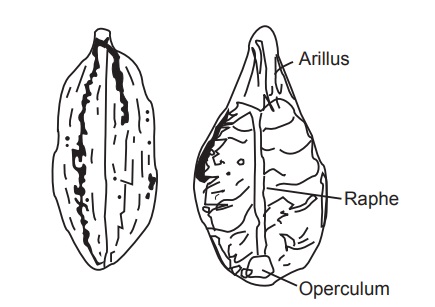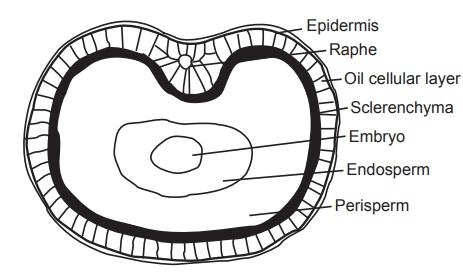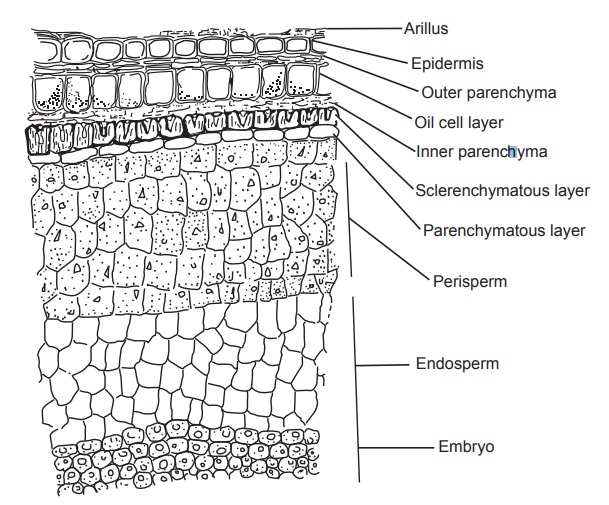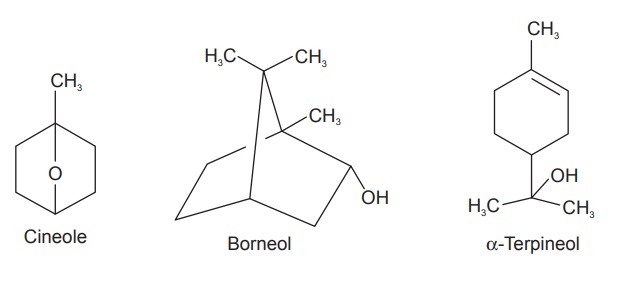Cardamom
| Home | | Pharmacognosy |Chapter: Pharmacognosy and Phytochemistry : Drugs Containing Volatile Oils
Cardamom consists of the dried ripe seeds of Elettaria car-damomum Maton., belonging to family Zingiberaceae.
CARDAMOM
Synonyms
Cardamom fruit, Cardamom seed, Cardamomi semina, Malabar
cardamums, Capalaga, Gujatatti elachi, Ilachi, Ailum.
Biological Source
Cardamom consists of the dried ripe seeds of Elettaria car-damomum Maton., belonging
to family Zingiberaceae.
Geographical Source
It is cultivated in South India and Ceylon. Like Mysore,
Kerala, etc.
History
According to the ancient literature, cardamom grew in the
gardens of the King of Babylon in 720 B.C. The ancient Egyptians chewed
cardamoms to whiten their teeth and at the same time to sweeten their breath.
The Indian Ayurvedic medicine during 4 B.C. used the spice to remove fat and to
treat urinary and skin complaints. Ancient Greeks and Romans used cardamom in
perfumes and a famous Roman epicure Apicius also recommended it to counteract
over-indulgence.
Cultivation and Collection
It is a large perennial herb, largely cultivated in forests
2,500 to 5,000 feet above sea-level in North Canara, Coorgi, and Wynaad. It
grows to a height of 6 to 10 feet from a thumb-thick, creeping rootstock. The
seeds are first sown in nurseries and then transplanted into rich moist soil,
when the seedlings are a year old or about 30 cm. Small crops are obtained
after the third year till six to seven years.
It flowers in April and May and the fruit gathering lasts in
dry weather for three months, starting in October when the colour turns from
green to yellow. (The methods of cultivating and preparing vary in different
districts) The collected fruits are washed to remove the impurities like sand,
and the fruits are dried quickly by putting them on trays in thin layers,
exposed to sunlight, with occasional sprinkling of water and dried.
Characteristics
Cardamom has simple, erect stems, the leaves are lanceolate,
upper surface is dark green and glabrous, whereas it is light green and silky
below. The small, yellowish flowers grow in loose racemes on prostrate flower
stems. The fruit is a three-celled capsule holding up to 18 seeds. The fruit is
an inferior trilocular three-angled capsule, 1 to 2 cm long, greenish to pale
buff or yellow in colour. They have an ovoid or oblong shape, rounded at the
base; the base has the remains of stalk or the perianth. Seeds are derived from
anatropous ovules and the seeds are attached in double rows with axile
placentation and the membraneous septa. The seeds are about 1/5 of an inch
long, angular, wrinkled and whitish inside. They should be powdered only when
wanted for use, as they lose their aromatic properties.

Microscopy
There is a very thin membraneous arillus, enveloping the
seed and composed of several layers of collapsed cells, yellow in colour, and
containing oil. The brownish testa is composed of an outer epidermis consisting
of a single layer of cells rectangular in transverse section, longitudinally
elongated and with parenchymatous end walls in surface view; light yellow in
colour and having slightly thick end walls; a single layer of large parenchymatous
cells containing volatile oil. In the region of the raphe there are two layers
of oil cells separated by the raphe meristele; several layers of small
flattened parenchymatous cells, and an inner epidermis of sclerenchymatous
cells, radially elongated, with anticlinal and inner walls very strongly
thickened and reddish-brown in colour. The operculum or embryonic cap is
composed of two or three layers of these sclerenchymatous cells. The micropyle
is a narrow canal passing through the operculum. Within the testa is a
well-developed perisperm composed of parenchymatous cells packed with minute
globular starch grains, and containing in the centre of each cell a small
prismatic crystal of calcium oxaiate. The perisperm encircles the endosperm and
embryo, both composed of thin-walled cells rich in protein.
Cardamom pericarps or husks is identified in the form of
powder by the pitted fibres and spiral vessels of the fibrovascular bundles and
by the abundant, empty parenchymatous cells.


Chemical Constituents
The seeds contain 3 to 6% of volatile oil along with fixed
oil, salts of potassium, a colouring principle, nitrogenous mucilage, an acrid
resin, starch, ligneous fibre, and ash. The active constituent of the volatile
oil is cineole. Other aromatic compounds present are terpinyl acetate,
terpineol, borneol, terpinene, etc. The oil is colourless when fresh, but
becomes thicker, more yellow and less aromatic on storage. It is soluble in
alcohol and readily in four volumes of 70% alcohol, producing a clear solution.
Its specific gravity at 25°C is 0.924 to 0.927.

Uses
Cardamom is used as an aromatic, carminative, stimulant,
stomachic, expectorant, diaphoretic, digestive, appetizer, and flavouring
agent. It is used in the treatment of respiratory disorders like asthma,
bronchitis, cough, nausea, vomiting, indigestion, headache, diarrhea, colds,
for flatulence, also used as a spice in cooking.
Allied Drug
1. Elettaria
cardamomum var. major: This species is the source of the long wild native Cardamom
of Sri Lanka. They are 4 cm long, pericarp is dark brown and coarsely striated.
Its volatile oil is used in liquors.
2. Amomum
aromaticum and A. subulatum: A. aromaticum is obtained
from Bengal and Assam and is known as Bengal Cardamom. A. subulatum is obtained from Nepal, Bengal, Sikkim, and Assam and
known as Nepal or Greater Cardamom. A.
subutalum contains petunidin-3,5-diglucoside, leucocyanidin-3-glucoside,
cardamonin, alpinetin, and aurone glucoside subulin.
3. Malabar Cardamom is characterized by
a short leafy shoot, 3 m in height, the fruit shape is roundish or elongated,
smaller than the Mysore Cardamom.
4. Mysore Cardamom is a robust with leafy
stem, up to 5 m high. Mysore Cardamom fruits are elongated, 2–5 cm long,
yellowish green when ripe, slightly arched, and darkish brown when dry; seeds
are numerous, large, and less aromatic.
5. Mangalore cardamom resembles the
Malabar but is more globular and has a rougher pericarp.
Adulteration
Cardamom fruits are often adulterated with orange seeds and
unroasted coffee grains. The adulterants of seeds are small pebbles and seeds
of Amomum spp. Powdered seeds are
adulterated with the powder of husks.
Marketed Products
It is one of the ingredients of the preparations known as
Koflet, Renalka syrup, Mentat and Anxocare (Himalaya Drug Company).
